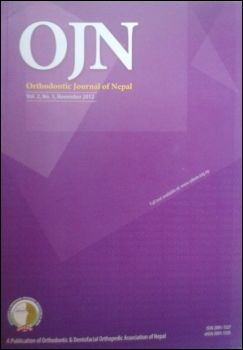Maxillary Impacted Canines: A Clinical Review
DOI:
https://doi.org/10.3126/ojn.v3i1.9285Abstract
Impacted teeth are those with a delayed eruption time or that are not expected to erupt completely based on clinical and radiographic assessment. Palatal displacement of the maxillary canines is defined as the developmental dislocation to a palatal site often resulting in tooth impaction requiring surgical and orthodontic treatments.
Impacted permanent maxillary canine occur in 1-2% of the population. The Occurrence of impacted permanent maxillary canines are; 85% palatal and 15% labial. The prevalence of palatally displaced canines (PDC) fluctuates between 0.8-5.2%. Palatally erupting or impacted maxillary canines occur twice often in females than males, and are five times more common in Caucasians than Asians. Of all patients with maxillary impacted canines, 8% have bilateral impactions.
DOI: http://dx.doi.org/10.3126/ojn.v3i1.9285
Orthodontic Journal of Nepal, Vol.3, No.1, 2013: 63-68
Downloads
Downloads
Published
How to Cite
Issue
Section
License
Copyright © held by Orthodontic & Dentofacial Orthopedic Association of Nepal
- Copyright on any research article is transferred in full to the Orthodontic & Dentofacial Orthopedic Association of Nepal upon publication in the journal. The copyright transfer includes the right to reproduce and distribute the article in any form of reproduction (printing, electronic media or any other form).
- Articles in the Orthodontic Journal of Nepal are Open Access articles published under the Creative Commons CC BY License (https://creativecommons.org/licenses/by/4.0/)
- This license permits use, distribution and reproduction in any medium, provided the original work is properly cited.




